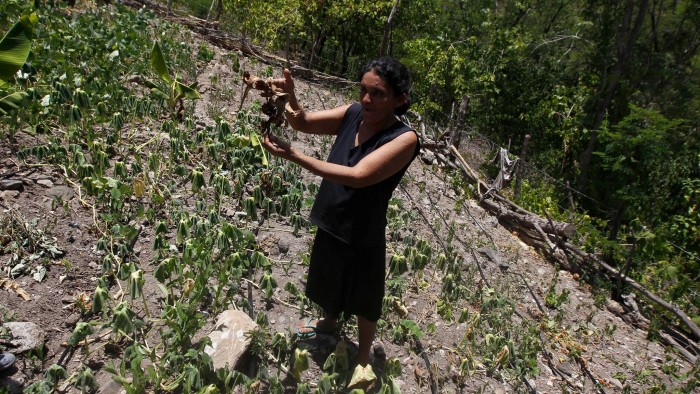Global food prices continue to fall despite climate concerns

Roula Khalaf, Editor of the FT, selects her favourite stories in this weekly newsletter.
When El Niño wreaked havoc on the world’s population during 2015, causing floods in Southeast Asia and rains in Brazil, it also damaged crops, especially sugar and palm oil. In October, prices shot up, particularly for sugar.
The sudden spike in sugar prices illustrated the economic impact of the unusual weather events triggered by El Niño, which is expected to further disrupt commodity prices in 2016. But the rise was a rare exception — international prices for most foods, including sugar and dairy, have been falling for the past four years.
Overall the Food and Agricultural Organisation’s food price index* was still 19 per cent lower in 2015 than the previous year, according to figures released on January 7. The index has been sliding in part because of the strengthening US dollar, which is the benchmark for global commodities, as well as the surplus in some food basics.
“Abundant supplies in the face of a timid world demand and an appreciating dollar are the main reason for the general weakness that dominated food prices in 2015,” Abdolreza Abbassian, a senior economist at the FAO, said.

Agricultural prices, as measured by the FAO’s price index, have fallen almost 30 per cent since 2011 as a result of increased production.
But the FAO acknowledges that extreme weather could still introduce some turbulence to global commodities markets. In Indonesia, El Niño caused the opposite problem to Brazil — excessive dryness, which affected the production of palm oil and briefly pushed up prices.
Reports of crop damage caused by drought in Thailand, India, the Philippines, South Africa and Vietnam also raised international prices of vegetable oils last year, rises that were amplified by fears of intensified damage from El Niño in 2016.
Stefan Vogel, head of agricultural commodity markets research at Rabobank, says the weather will continue to be a key driver in commodities markets over the next year. “We currently see El Niño, one of the strongest on record, affecting sugar, cocoa, palm oil and robusta coffee crops,” he says. “El Niño is expected to gradually weaken in the first quarter of 2016, but its effects will continue to affect the commodity price.”
Weather patterns associated with El Niño are also expected to hit cereal production in parts of Africa, Asia and Oceania, while several countries in Central America and the Caribbean, as well as in Asia, have already been affected. Dry weather in northern India cut local cereal production in the 2015 season.
Nevertheless cereal costs have fallen, especially the price of coarse grains, due to favourable harvests in the world’s largest producer, the US. Although rice, wheat and maize make up about two-thirds of the world’s food consumption, no one is forecasting a return to the febrile markets of 2007 and 2008, when record highs in food prices sparked a series of riots. Wheat supplies remain high and prices relatively low as a result of record production of grains and oilseeds from South Africa.
But the FAO’s Cereal Supply and Demand Brief has slightly trimmed its forecast for world cereal production in 2015/16, which is now 2.53bn tonnes, or 1.3 per cent below the previous year’s record.
Lower oil prices will curb demand for biofuel crops. As a result, the use of cereal worldwide is expected to grow by just 1 per cent in 2015/16. “All in all, we expect grains to continue to trade around current levels, as weather-related risks are counterbalanced by currency weakness in many key producing countries, whereas we expect some upside on coffee, sugar and cotton,” says Mr Vogel.
In 2015, all agricultural sectors covered by the FAO’s food price index posted double digit declines. Dairy prices led the way, with average prices down 28.5 per cent, suggesting that importers have adequate stocks. Sugar fell 21 per cent, vegetable oils declined 19 per cent, cereals shed 15.4 per cent and meat lost 15.1 per cent.
Meanwhile, the FAO continues to stress that food security remains a great concern. People in some 33 countries, with the majority in Africa, may face food shortages either because of El Niño-caused drought and floods, or violent conflicts, particularly in Syria and Yemen.
* The FAO food price index is a monthly trade-weighted measure tracking prices on international markets of five major food commodity groups: cereals, meat, dairy products, vegetable oils and sugar.
This story has been amended since publication to reflect the fact that a forecast for maize production in China was the primary reason for a downward revision for the month of December, not the whole year.
Comments